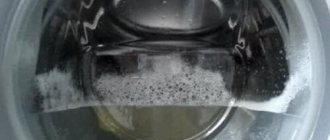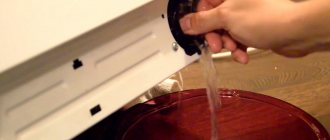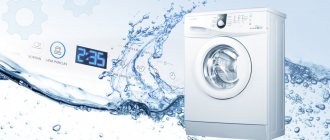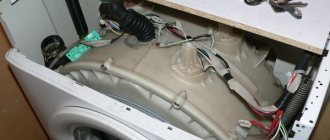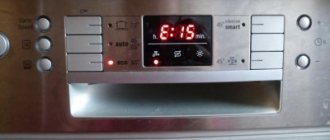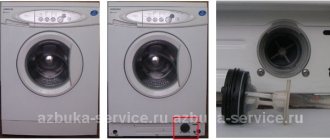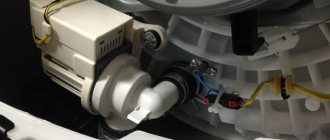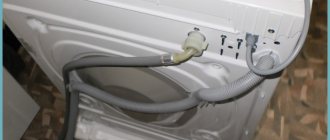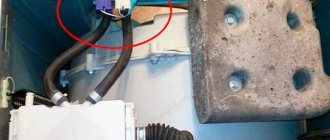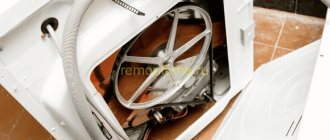machines » The washing machine takes in water and immediately drains.
The quality and duration of the wash depend on the supply of water and its proper circulation - if the washing machine does not hold water, the process will either be interrupted or go into a so-called cycle, when the drum spins endlessly and the machine does not switches to rinse and spin mode. How to find the causes of this problem, how to fix it, do you need to contact a specialist, or is it possible to solve it yourself?
The service center offers high-quality services - repair of washing machines at home in Moscow and the Moscow region with a prompt visit of a specialist.
Leave a request to call a specialist on the company’s website or call us at +7 (495) 745-24-00 . We serve customers from 8.00 to 23.00 every day, including weekends and holidays. The company provides a warranty on the results of the work of the master and the installed parts.
Why does the washing machine fill with water and immediately drain it?
This is a fairly common problem, familiar to owners of Samsung, Indesit, Bosch, Candy, LG, Ardo, Zanussi, Electrolux, Beko equipment - the washing machine fills and immediately drains water, and because of this, washing or rinsing does not start. Finding the cause on your own is limited to checking external factors - the correct connection, the condition of the water supply and sewage system, filters and siphon. Internal factors - breakdowns and malfunctions can only be identified by a service center technician when diagnosing the machine at home.
To check the machine, there are professional techniques, technological maps, instruments and various operations with the control panel. Diagnostics remains the main condition for a complete repair, which does not have to be repeated after a short period of time.
The main reasons for water discharge from a washing machine:
- incorrect connection, incorrect position of hoses;
- erroneous operation of the relief valve;
- malfunction of the sensor for the presence and level of water in the machine;
- failure in the control module.
Most of these reasons relate to breakdowns and malfunctions in the machine itself, so a little depends on you. Full diagnostics and troubleshooting are carried out by a service center technician.
Let's look at the reasons in more detail; the service center technicians will tell us about identifying and eliminating them.
The washing machine is not connected correctly
When connecting the washing machine to the sewer, the condition from the instructions was not met - the hose was located below the specified level, and the water began to flow into the siphon on its own. This may serve as an indirect sign of a malfunction of the exhaust valve, which should prevent such a development of events.
Valve failure
The water discharge valve is faulty; it does not ensure the tightness of the outlet, and when the pump is turned on, instead of circulating, the water is directed to discharge and leaves the washing machine. As a result, the pressure switch is triggered, signaling a lack of water, and the electronics stops executing the program.
Unstable pressure in the water supply
When filling with water at the beginning of the wash or when replacing waste water with clean water, the pressure in the water supply does not allow filling the tank. This may cause water to be discharged and the wash program to stop. If there is excess pressure, the valve will not completely close the inlet, and water will begin to flow into the machine without stopping.
Blockage in the sewer
The problem is familiar to those who live in old houses with narrow sewer pipes. When they are filled, a vacuum appears on the lower floors above, which “pulls” water out of the washing machine.
Broken water level sensor - pressure switch
A malfunction of the pressure switch or water level sensor in the tank causes it to send an incorrect signal to the control unit. It reacts with an additional set of water, which overflows the tank and drains into the sewer. In some cases, a malfunction of the pressure switch can lead to the pump being turned on to drain and the valves to urgently empty the tank. After replacing the sensor, the malfunction is considered completely eliminated. This is a fairly rare case, since not all models of washing machines are designed for emergency water discharge.
The washing machine tank leaked, the hose burst, the connections came loose
The washing machine does not hold water if the tank leaks, the tightness of the connections is broken, or the pump housing is damaged. In this case, you will find a puddle on the floor, but the service center technician will have to look for the leak. There may be several such damages at different points in the circulation system.
The electronic control module is broken
The washing machine drains water without washing if a signal is received from the control unit to the reset valve. This indicates a malfunction in the block itself, which began to generate incorrect commands. When diagnosing, it is necessary to exclude a malfunction of the valve and pressure switch. A glitch in the program can put the machine into a cycle - it will constantly take in and dump water.
Signs and causes of the problem
Please note when you find that there is water left in the washer:
- After the wash cycle, while removing laundry from the drum. Things didn't work out well.
- When the car froze, a fault code appeared on the display. In this case, the hatch door does not open.
Why do such breakdowns occur? There may be the following reasons:
- The drain hose is kinked or there is a blockage in the drain system.
- The drain pump is broken.
- The pressure switch (pressure switch) is faulty.
- The electronic board is faulty.
Washing machine does not hold water - consequences
How dangerous is the situation when the washing machine drains water constantly - during the entire washing process?
- This is a huge waste of water, which negates all the savings from washing with an automatic machine.
- When constantly drawing water from the water supply, there is a risk of the tank overflowing and water leaking onto the floor.
- The pump often turns on for drainage - because of this, it quickly wears out and becomes unusable.
- The quality of washing decreases, since all the powder dissolved in water goes down the drain.
The pump is broken
Nothing lasts forever - the pump may simply fail. It is located at the bottom of the case, but not all models have easy access to it. Before disassembling the machine, you should carefully read the instructions and find where exactly the part is located. The pump has an impeller that often gets clogged.
If after cleaning a miracle does not happen, it means the winding has burned out and the part needs to be replaced. Depending on the model, select a pump, disconnect the pipes from the broken one and connect to the new one.
Water is leaking from the washing machine - what should I do?
First, you should make sure that the hose has not come off the loops on the back of the machine. You can fix it yourself and thus solve the problem. How to make sure that water is constantly draining from the machine? To do this, just fill the tank with water, start the drain mode and pause the execution. If the water goes away. You will hear a constant noise in the drain hose and siphon.
If the water pressure in the water supply is unstable, it is recommended to install filters with pressure regulators, but this should be done professionally so that the machine fills quickly enough and does not delay the washing time.
The control system has failed
Everyone is accustomed to the fact that in modern automatic machines, water is drawn and drained automatically; control module programs are responsible for everything. It controls the temperature of the heating element, turns on the drain pump, regulates the power of the electric motor, and controls the water pressure during supply.
A common cause of breakdown is a manufacturing defect, failure of auxiliary sensors, or a simple flood of water. Therefore, if the inlet valve has already been replaced and the machine is still not working properly, then the board has failed.
Indesit, Samsung and BEKO cover their boards with sealant in some models. If, when opening the front panel, changes in color, swelling, or burnout are found on the microcircuit, then it is better to call a technician who knows how to handle a blowtorch. If you do not have sufficient knowledge, you should not repair the circuit yourself.
If drops are visible on the board, but there is no noticeable damage, you can dry the chip, in most cases this gives a positive result.
The washing machine does not hold water - should I call a professional?
In this case, you need to call a specialist! Even if the problem is due to unrelated reasons, there is a high probability that your washing machine has been working for a long time. It is necessary to check the condition of the pump, valves and hoses.
If, as a result of diagnostics, it turns out that the cause of the water drainage was a pressure switch or valve, then these parts must be replaced with new ones. They cannot be rebuilt or restored. You will not be able to save on machine repairs if such a malfunction occurs - the consumption of water and electricity due to the constant set and increase in the duration of the wash will be enormous.
Intake valve failure
The inlet valve operates simultaneously with the pressure switch. This is a component that must control the flow of fluid into the unit.
If during the washing process the machine begins to constantly take in water, it is recommended to check the valve for damage. If the equipment does not have cracks or other visible integrity problems, it is tested using a multimeter. The operating resistance of a working device is 2-4 kOhm.
If faults are found, the valve is completely replaced. It is better to entrust this work to a master who repairs equipment. Solving the problem yourself, you can damage the fasteners, connect the wires incorrectly, which will cause a short circuit.
Troubleshooting with a guarantee or saving on repairs?
You should not contact your friends or random repairmen - they will not give you guarantees of the quality of the repair, they may install old and substandard spare parts, which means that your claims will not be satisfied.
Manufacturers require compliance with repair regulations, which means that a limited range of spare parts is allowed for installation on the machine. You will not be able to purchase them on your own, because their price for a service center and an individual is noticeably different.
The cost of repair depends on what parts had to be replaced after diagnosis. It can be calculated after the technician finds the cause of the malfunction and accurately determines the list of spare parts for replacement.
Our service center specialists use only new and conditioned components that are covered by the manufacturer’s warranty.
Incorrect connection
If the machine was installed relatively recently, it is quite possible that the cause of the water overflow is its incorrect connection. So, if the drain hose is located lower than the washing machine tank, water can drain uncontrollably into the sewer. In such a situation, the water level sensor will signal the need to add liquid. Due to the constant flow of water into the sewer, its flow into the tank simply cannot stop.
A connection in which the drain hose is fixed at a height of about 60 centimeters from the floor level is considered normal. It is usually connected to a sewer pipe or siphon.
If it is impossible to check at what level the hose is located due to a protrusion on the wall, a cabinet or other reasons, you can conduct a small experiment. To do this, you need to start the machine in the usual mode and wait until the tank is filled with water. The next step is to activate the drain, after 5-7 seconds - pause. Now you need to monitor the water level in the car for a few minutes. So, if the drainage stops when the pause button is activated, it means that the machine is connected correctly and the reason for the constant unauthorized intake of water is a malfunction of some other component. An incorrect connection will be indicated by continued drainage, which will be accompanied by a characteristic murmur in the pipes. After discovering the cause of the malfunction, you should reconnect the machine, following the instructions. No special skills are required to perform this washing machine repair.
Testing the washing machine for correct hose connection
If you can't easily reach the connection between the drain and the drain hose on your car, there is a simple test you can do to help you figure out if the problem is actually a faulty connection.
- Set your machine to the simple wash cycle, but do not put laundry in the drum.
- Turn on the machine and watch when the water fills the drum and it stops spinning.
- At this point, you should pause and see if the water level in the drum drops immediately. If this happens and there is not enough water, the machine drains the water by gravity. The hose is not connected correctly.
What to do next? Still get to the place where the hose connects to the sewer pipe and move it to the required height. If you cannot do this yourself or these actions were not enough and they did not help, contact a specialist.
